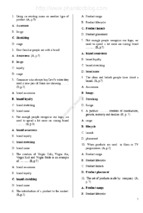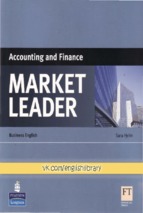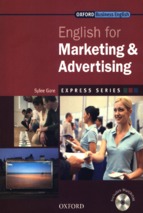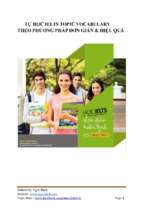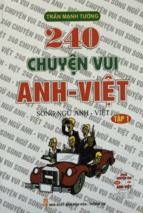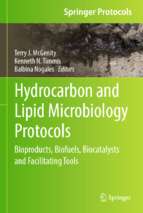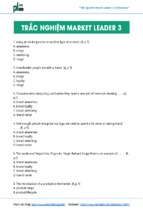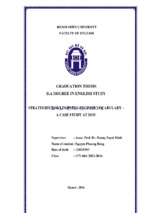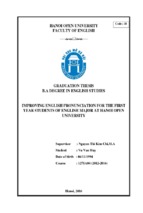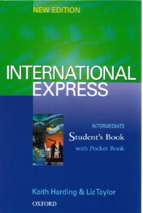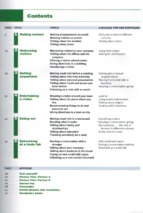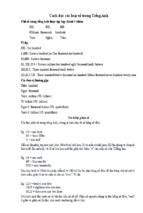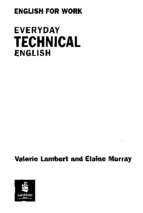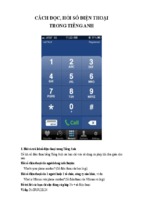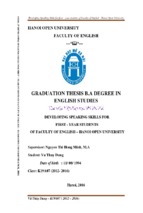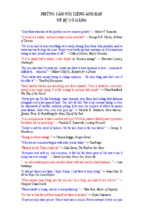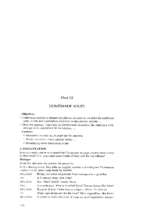Tổng hợp lý thuyết tiêu chuẩn cho 4 kỹ năng về tiếng Anh: Nghe, nói , đọc, viết: "The reading, writing, speaking and listening standards describe what students should know and be able with the English language at four grade levels, provide the targets for instruction and student learning essential for success in all academic areas.
22 Pennsylvania Code, Chapter 4
APPENDIX A
Academic Standards for Reading, Writing, Speaking
and Listening
and
Academic Standards for Mathematics
Academic Standards for
Reading, Writing, Speaking
and Listening
Pennsylvania Department of Education
Academic Standards for Reading, Writing, Speaking and Listening
I. TABLE OF CONTENTS
Introduction… … … … … … … … … … … … … … … … … … … … .
II.
THE ACADEMIC STANDARDS
Learning to Read Independently… … … … … … … … … … … ...
Purposes for Reading
Word Recognition Skills
Vocabulary Development
Comprehension and Interpretation
Fluency
1.1.
Quality of Writing… … … … … … … … … … … … … … … … … ...
Focus
Content
Organization
Style
Conventions
1.5.
Reading Critically in All Content Areas… … … … … … … … ...
Detail
Inferences
Fact from Opinion
Comparison
Analysis and Evaluation
1.2.
Speaking and Listening… … … … … … … … … … … … … … … ...
Listening Skills
Speaking Skills
Discussion
Presentation
1.6.
Reading, Analyzing and Interpreting Literature… … … … … .
Literary Elements
Literary Devices
Poetry
Drama
1.3.
Characteristics and Function of the English Language… … ...
Word Origins
Variations
Application
1.7.
Types of Writing… … … … … … … … … … … … … … … … … … ..
Narrative
Informational
Persuasive
1.4.
Research… … … … … … … … … … … … … … … … … … … … … ...
Selection
Location of Information
Organization
1.8.
Glossary… … … … … … … … … … … … … … … … … … … … … …
III.
Academic Standards for Reading, Writing, Speaking and Listening
II. INTRODUCTION
This document includes Reading, Writing, Speaking and Listening Standards:
◊
◊
◊
◊
1.1.
1.2.
1.3.
1.4.
Learning to Read Independently
Reading Critically in All Content Areas
Reading, Analyzing and Interpreting Literature
Types of Writing
◊
◊
◊
◊
1.5.
1.6.
1.7.
1.8.
Quality of Writing
Speaking and Listening
Characteristics and Function of the English Language
Research
The Reading, Writing, Speaking and Listening Standards describe what students should know and be able to do with the English
language at four grade levels (third, fifth, eighth and eleventh). The standards provide the targets for instruction and student learning
essential for success in all academic areas, not just language arts classrooms. Although the standards are not a curriculum or a
prescribed series of activities, school entities will use them to develop a local school curriculum that will meet local students’needs.
The language arts— Reading, Writing, Speaking and Listening— are unique because they are processes that students use to learn and
make sense of their world. Students do not read “reading”; they read about history, science, mathematics and other content areas as
well as about topics for their interest and entertainment. Similarly, students do not write “writing”; they use written words to express
their knowledge and ideas and to inform or entertain others.
Because of the unique nature of the language arts, all teachers in a school will use the Reading, Writing, Speaking and Listening
Standards. The standards define the skills and strategies employed by effective readers and writers; therefore, all teachers will assist
their students in learning them through multiple classroom situations in all the subject areas.
The Reading, Writing, Speaking and Listening Standards also provide parents and community members with information about what
students should know and be able to do as they progress through the educational program and at graduation. With a clearly defined
target provided by the standards, parents, students, educators and community members become partners in learning success.
A glossary is included to assist the reader in understanding terminology contained in the standards.
1
Academic Standards for Reading, Writing, Speaking and Listening
1.1. Learning to Read Independently
1.1.3. GRADE 3
1.1.5. GRADE 5
1.1.8. GRADE 8
1.1.11. GRADE 11
Pennsylvania’ public schools shall teach, challenge and support every student to realize his or her maximum potential and to acquire the
s
knowledge and skills needed to:
A. Identify the purposes and types of text
(e.g., literature, information) before
reading.
A. Establish the purpose for reading a
type of text (literature, information)
before reading.
A. Locate appropriate texts (literature,
information, documents) for an
assigned purpose before reading.
A. Locate various texts, media and
traditional resources for assigned and
independent projects before reading.
B. Preview the text formats (e.g., title,
headings, chapters and table of
contents).
B. Select texts for a particular purpose
using the format of the text as a guide.
B. Identify and use common
organizational structures and graphic
features to comprehend information.
B. Analyze the structure of informational
materials explaining how authors used
these to achieve their purposes.
C. Use knowledge of phonics, word
analysis (e.g., root words, prefixes and
suffixes), syllabication, picture and
context clues to decode and understand
new words during reading.
C. Use knowledge of phonics,
syllabication, prefixes, suffixes, the
dictionary or context clues to decode
and understand new words during
reading. Use these words accurately in
writing and speaking.
C. Use knowledge of root words as well
as context clues and glossaries to
understand specialized vocabulary in
the content areas during reading. Use
these words accurately in speaking and
writing.
C. Use knowledge of root words and
words from literary works to recognize
and understand the meaning of new
words during reading. Use these
words accurately in speaking and
writing.
D. Read text using self-monitoring
comprehension strategies (e.g., predict,
revise predictions, reread, use text
organization including headings,
graphics, and charts, and adjust
reading rate).
D. Identify the basic ideas and facts in
text using strategies (e.g., prior
knowledge, illustrations and headings)
and information from other sources to
make predictions about text.
D. Identify basic facts and ideas in text
using specific strategies (e.g., recall
genre characteristics, set a purpose for
reading, generate essential questions as
aids to comprehension and clarify
understanding through rereading and
discussion).
D. Identify, describe, evaluate and
synthesize the essential ideas in text.
Assess those reading strategies that
were most effective in learning from a
variety of texts.
E. Acquire a reading vocabulary by
identifying and correctly using words
(e.g., antonyms, synonyms, categories
of words). Use a dictionary when
appropriate.
E. Acquire a reading vocabulary by
correctly identifying and using words
(e.g., synonyms, homophones,
homographs, words with roots,
suffixes, prefixes). Use a dictionary
or related reference.
E. Expand a reading vocabulary by
identifying and correctly using idioms
and words with literal and figurative
meanings. Use a dictionary or related
reference.
E. Establish a reading vocabulary by
identifying and correctly using new
words acquired through the study of
their relationships to other words. Use
a dictionary or related reference.
2
Academic Standards for Reading, Writing, Speaking and Listening
F. Understand the meaning of and use
correctly new vocabulary learned in
various subject areas.
F. Identify, understand the meaning of
and use correctly key vocabulary from
various subject areas.
F. Understand the meaning of and apply
key vocabulary across the various
subject areas.
F. Understand the meaning of and apply
key vocabulary across the various
subject areas.
G. Demonstrate after reading
understanding and interpretation of
both fiction and nonfiction text.
• Retell or summarize the major
ideas, themes or procedures of the
text.
• Connect the new information or
ideas in the text to known
information.
• Clarify ideas and understandings
through rereading and discussion.
• Make responsible assertions about
the text by citing evidence from
the text.
G. Demonstrate after reading
understanding and interpretation of
both fiction and nonfiction text.
• Summarize the major ideas,
themes or procedures of the text.
• Relate new information or ideas
from the text to that learned
through additional reading and
media (e.g., film, audiotape).
• Clarify ideas and understandings
through rereading and discussion.
• Make responsible assertions about
the ideas from the text by citing
evidence.
• Extend ideas found in the text.
G. Demonstrate after reading
understanding and interpretation of
both fiction and nonfiction text,
including public documents.
• Make, and support with evidence,
assertions about texts.
• Compare and contrast texts using
themes, settings, characters and
ideas.
• Make extensions to related ideas,
topics or information.
• Describe the context of a
document.
• Analyze the positions, arguments
and evidence in public documents.
G. Demonstrate after reading
understanding and interpretation of
both fiction and nonfiction text,
including public documents.
• Make, and support with evidence,
assertions about texts.
• Compare and contrast texts using
themes, settings, characters and
ideas.
• Make extensions to related ideas,
topics or information.
• Assess the validity of the
document based on context.
• Analyze the positions, arguments
and evidence in public documents.
• Evaluate the author’ strategies.
s
• Critique public documents to
identify strategies common in
public discourse.
H. Demonstrate fluency and
comprehension in reading.
• Read familiar materials aloud with
accuracy.
• Self-correct mistakes.
• Use appropriate rhythm, flow,
meter and pronunciation.
• Read a variety of genres and types
of text.
• Demonstrate comprehension
(Standard 1.1.3.G.).
(Recommend: 25 books/year)
H. Demonstrate fluency and
comprehension in reading.
• Read familiar materials aloud with
accuracy.
• Self-correct mistakes.
• Use appropriate rhythm, flow,
meter and pronunciation.
• Read a variety of genres and types
of text.
• Demonstrate comprehension
(Standard 1.1.5.G.).
(Recommend: 25 books/year)
H. Demonstrate fluency and
comprehension in reading.
• Read familiar materials aloud with
accuracy.
• Self-correct mistakes.
• Use appropriate rhythm, flow,
meter and pronunciation.
• Read a variety of genres and types
of text.
• Demonstrate comprehension
(Standard 1.1.8.G.).
(Recommend: 25 books/year)
H. Demonstrate fluency and
comprehension in reading.
• Read familiar materials aloud with
accuracy.
• Self-correct mistakes.
• Use appropriate rhythm, flow,
meter and pronunciation.
• Read a variety of genres and types
of text.
• Demonstrate comprehension
(Standard 1.1.11.G.).
(Recommend: 25 books/year)
3
Academic Standards for Reading, Writing, Speaking and Listening
1.2. Reading Critically in All Content Areas
1.2.3. GRADE 3
1.2.5. GRADE 5
1.2.8. GRADE 8
1.2.11. GRADE 11
Pennsylvania’ public schools shall teach, challenge and support every student to realize his or her maximum potential and to acquire the
s
knowledge and skills needed to:
A. Read and understand essential content
of informational texts and documents
in all academic areas.
• Differentiate fact from opinion
within text.
• Distinguish between essential and
nonessential information within a
text.
• Make inferences from text when
studying a topic (e.g., science,
social studies) and draw
conclusions based on text.
• Analyze text organization and
content to derive meaning from
text using established criteria.
A. Read and understand essential content
of informational texts and documents
in all academic areas.
• Differentiate fact from opinion
across texts.
• Distinguish between essential and
nonessential information across a
variety of texts, identifying
stereotypes and exaggeration
where present.
• Make inferences about similar
concepts in multiple texts and
draw conclusions.
• Evaluate text organization and
content to determine the author’
s
purpose and effectiveness.
A. Read and understand essential content
of informational texts and documents
in all academic areas.
• Differentiate fact from opinion
utilizing resources that go beyond
traditional text (e.g., newspapers,
magazines and periodicals) to
electronic media.
• Distinguish between essential and
nonessential information across
texts and going beyond texts to a
variety of media; identify bias and
propaganda where present.
• Draw inferences based on a
variety of information sources.
• Evaluate text organization and
content to determine the author’
s
purpose and effectiveness
according to the author’ theses,
s
accuracy and thoroughness.
A. Read and understand essential content
of informational texts and documents
in all academic areas.
• Differentiate fact from opinion
across a variety of texts by using
complete and accurate
information, coherent arguments
and points of view.
• Distinguish between essential and
nonessential information across a
variety of sources, identifying the
use of proper references or
authorities and propaganda
techniques where present.
• Use teacher and student
established criteria for making
decisions and drawing
conclusions.
• Evaluate text organization and
content to determine the author’
s
purpose and effectiveness
according to the author’ theses,
s
accuracy, thoroughness, logic and
reasoning.
4
Academic Standards for Reading, Writing, Speaking and Listening
B. Use and understand a variety of media
and evaluate the quality of material
produced.
• Use electronic media for research.
• Identify techniques used in
television and use the knowledge to
distinguish between facts and
misleading information.
• Assess the quality of media project
(e.g., script, play, audiotape) that
has been developed for a targeted
audience.
B. Use and understand a variety of media
and evaluate the quality of material
produced.
• Use a variety of media (e.g.,
computerized card catalogues,
encyclopedias) for research.
• Evaluate the role of media as a
source of both entertainment and
information.
• Use established criteria to design
and develop a media project (e.g.,
script, play, audiotape) for a
targeted audience.
B. Use and understand a variety of media
and evaluate the quality of material
produced.
• Compare and analyze how
different media offer a unique
perspective on the information
presented.
• Analyze the techniques of
particular media messages and
their effect on a targeted audience.
• Use, design and develop a media
project that expands
understanding (e.g., authors and
works from a particular historical
period).
B. Use and understand a variety of media
and evaluate the quality of material
produced.
• Select appropriate electronic
media for research and evaluate
the quality of the information
received.
• Explain how the techniques used
in electronic media modify
traditional forms of discourse for
different purposes.
• Use, design and develop a media
project to demonstrate
understanding (e.g., a major writer
or literary period or movement).
C. Produce work in at least one literary
genre that follows the conventions of
the genre.
C. Produce work in at least one literary
genre that follows the conventions of
the genre.
C. Produce work in at least one literary
genre that follows the conventions of
the genre.
C. Produce work in at least one literary
genre that follows the conventions of
the genre.
5
Academic Standards for Reading, Writing, Speaking and Listening
1.3. Reading, Analyzing and Interpreting Literature
1.3.3. GRADE 3
1.3.5. GRADE 5
1.3.8. GRADE 8
1.3.11. GRADE 11
Pennsylvania’ public schools shall teach, challenge and support every student to realize his or her maximum potential and to acquire the
s
knowledge and skills needed to:
A. Read and understand works of
literature.
A. Read and understand works of
literature.
A. Read and understand works of
literature.
A. Read and understand works of
literature.
B. Identify literary elements in stories
describing characters, setting and plot.
B. Compare the use of literary elements
within and among texts including
characters, setting, plot, theme and
point of view.
B. Analyze the use of literary elements
by an author including
characterization, setting, plot, theme,
point of view, tone and style.
B. Analyze the relationships, uses and
effectiveness of literary elements used
by one or more authors in similar
genres including characterization,
setting, plot, theme, point of view,
tone and style.
C. Identify literary devices in stories
(e.g., rhyme, rhythm, personification).
C. Describe how the author uses literary
devices to convey meaning.
• Sound techniques (e.g., rhyme,
rhythm, meter, alliteration).
• Figurative language (e.g.,
personification, simile, metaphor,
hyperbole).
C. Analyze the effect of various literary
devices.
• Sound techniques (e.g., rhyme,
rhythm, meter, alliteration).
• Figurative language (e.g.,
personification, simile, metaphor,
hyperbole, allusion).
C. Analyze the effectiveness, in terms of
literary quality, of the author’ use of
s
literary devices.
• Sound techniques (e.g., rhyme,
rhythm, meter, alliteration).
• Figurative language (e.g.,
personification, simile, metaphor,
hyperbole, irony, satire).
• Literary structures (e.g.,
foreshadowing, flashbacks,
progressive and digressive time).
D. Identify the structures in poetry (e.g.,
pattern books, predictable books,
nursery rhymes).
D. Identify and respond to the effects of
sound and structure in poetry (e.g.,
alliteration, rhyme, verse form).
D. Identify poetic forms (e.g., ballad,
sonnet, couplet).
D. Analyze and evaluate in poetry the
appropriateness of diction and
figurative language (e.g., irony,
understatement, overstatement,
paradox).
6
Academic Standards for Reading, Writing, Speaking and Listening
E. Identify the structures in drama (e.g.,
dialogue, story enactment, acts,
scenes).
E. Analyze drama as information source,
entertainment, persuasion or
transmitter of culture.
E. Analyze drama to determine the
reasons for a character’ actions taking
s
into account the situation and basic
motivation of the character.
E. Analyze how a scriptwriter’ use of
s
words creates tone and mood, and how
choice of words advances the theme or
purpose of the work.
F. Read and respond to nonfiction and
fiction including poetry and drama.
F. Read and respond to nonfiction and
fiction including poetry and drama.
F. Read and respond to nonfiction and
fiction including poetry and drama.
F. Read and respond to nonfiction and
fiction including poetry and drama.
7
Academic Standards for Reading, Writing, Speaking and Listening
1.4. Types of Writing
1.4.3. GRADE 3
1.4.5. GRADE 5
1.4.8. GRADE 8
1.4.11. GRADE 11
Pennsylvania’ public schools shall teach, challenge and support every student to realize his or her maximum potential and to acquire the
s
knowledge and skills needed to:
A. Write narrative pieces (e.g., stories,
poems, plays).
• Include detailed descriptions of
people, places and things.
• Use relevant illustrations.
• Include literary elements
(Standard 1.3.3.B.).
A. Write poems, plays and multiparagraph stories.
• Include detailed descriptions of
people, places and things.
• Use relevant illustrations.
• Utilize dialogue.
• Apply literary conflict.
• Include literary elements
(Standard 1.3.5.B.).
• Use literary devices
(Standard 1.3.5.C.).
A. Write short stories, poems and plays.
• Apply varying organizational
methods.
• Use relevant illustrations.
• Utilize dialogue.
• Apply literary conflict.
• Include literary elements
(Standard 1.3.8.B.) .
• Use literary devices
(Standard 1.3.8.C.).
A. Write short stories, poems and plays.
• Apply varying organizational
methods.
• Use relevant illustrations.
• Utilize dialogue.
• Apply literary conflict.
• Include varying characteristics
(e.g., from limerick to epic, from
whimsical to dramatic).
• Include literary elements
(Standard 1.3.11.B.) .
• Use literary devices
(Standard 1.3.11.C.).
B. Write informational pieces (e.g.,
descriptions, letters, reports,
instructions) using illustrations when
relevant.
B. Write multi-paragraph informational
pieces (e.g., essays, descriptions,
letters, reports, instructions).
• Include cause and effect.
• Develop a problem and solution
when appropriate to the topic.
• Use relevant graphics (e.g., maps,
charts, graphs, tables,
illustrations, photographs).
B. Write multi-paragraph informational
pieces (e.g., letters, descriptions,
reports, instructions, essays, articles,
interviews).
• Include cause and effect.
• Develop a problem and solution
when appropriate to the topic.
• Use relevant graphics (e.g., maps,
charts, graphs, tables,
illustrations, photographs).
• Use primary and secondary
sources.
B. Write complex informational pieces
(e.g., research papers, analyses,
evaluations, essays).
• Include a variety of methods to
develop the main idea.
• Use precise language and specific
detail.
• Include cause and effect.
• Use relevant graphics (e.g., maps,
charts, graphs, tables,
illustrations, photographs).
• Use primary and secondary
sources.
8
Academic Standards for Reading, Writing, Speaking and Listening
C. Write an opinion and support it with
facts.
C. Write persuasive pieces with a clearly
stated position or opinion and
supporting detail, citing sources when
needed.
C. Write persuasive pieces.
• Include a clearly stated position
or opinion.
• Include convincing, elaborated
and properly cited evidence.
• Develop reader interest.
• Anticipate and counter reader
concerns and arguments.
C. Write persuasive pieces.
• Include a clearly stated position
or opinion.
• Include convincing, elaborated
and properly cited evidence.
• Develop reader interest.
• Anticipate and counter reader
concerns and arguments.
• Include a variety of methods to
advance the argument or position.
D. Maintain a written record of activities,
course work, experience, honors and
interests.
D. Maintain a written record of activities,
course work, experience, honors and
interests.
E. Write a personal resum¾.
9
Academic Standards for Reading, Writing, Speaking and Listening
1.5. Quality of Writing
1.5.3. GRADE 3
1.5.5. GRADE 5
1.5.8. GRADE 8
1.5.11. GRADE 11
Pennsylvania’ public schools shall teach, challenge and support every student to realize his or her maximum potential and to acquire the
s
knowledge and skills needed to:
A. Write with a sharp, distinct focus
identifying topic, task and audience.
A. Write with a sharp, distinct focus
identifying topic, task and audience.
A. Write with a sharp, distinct focus.
• Identify topic, task and audience.
• Establish a single point of view.
A. Write with a sharp, distinct focus.
• Identify topic, task and audience.
• Establish and maintain a single
point of view.
B. Write using well-developed content
appropriate for the topic.
• Gather and organize information.
• Write a series of related sentences
or paragraphs with one central
idea.
• Incorporate details relevant and
appropriate to the topic.
B. Write using well-developed content
appropriate for the topic.
• Gather, organize and select the
most effective information
appropriate for the topic, task and
audience.
• Write paragraphs that have a
topic sentence and supporting
details.
B. Write using well-developed content
appropriate for the topic.
• Gather, determine validity and
reliability of and organize
information.
• Employ the most effective format
for purpose and audience.
• Write paragraphs that have details
and information specific to the
topic and relevant to the focus.
B. Write using well-developed content
appropriate for the topic.
• Gather, determine validity and
reliability of, analyze and
organize information.
• Employ the most effective format
for purpose and audience.
• Write fully developed paragraphs
that have details and information
specific to the topic and relevant
to the focus.
C. Write with controlled and/or subtle
organization.
• Sustain a logical order.
• Include a recognizable beginning,
middle and end.
C. Write with controlled and/or subtle
organization.
• Sustain a logical order within
sentences and between
paragraphs using meaningful
transitions.
• Include an identifiable
introduction, body and
conclusion.
C. Write with controlled and/or subtle
organization.
• Sustain a logical order within
sentences and between
paragraphs using meaningful
transitions.
• Establish topic and purpose in the
introduction.
• Reiterate the topic and purpose in
the conclusion.
C. Write with controlled and/or subtle
organization.
• Sustain a logical order throughout
the piece.
• Include an effective introduction
and conclusion.
10
Academic Standards for Reading, Writing, Speaking and Listening
D. Write with an awareness of the
stylistic aspects of composition.
• Use sentences of differing lengths
and complexities.
• Use descriptive words and action
verbs.
D. Write with an understanding of the
stylistic aspects of composition.
• Use different types and lengths of
sentences.
• Use precise language including
adjectives, adverbs, action verbs
and specific details that convey
the writer’ meaning.
s
• Develop and maintain a
consistent voice.
D. Write with an understanding of the
stylistic aspects of composition.
• Use different types and lengths of
sentences.
• Use tone and voice through the
use of precise language.
D. Write with a command of the stylistic
aspects of composition.
• Use different types and lengths of
sentences.
• Use precise language.
E. Revise writing to improve detail and
order by identifying missing
information and determining whether
ideas follow logically.
E. Revise writing to improve
organization and word choice; check
the logic, order of ideas and precision
of vocabulary.
E. Revise writing after rethinking logic
of organization and rechecking central
idea, content, paragraph development,
level of detail, style, tone and word
choice.
E. Revise writing to improve style, word
choice, sentence variety and subtlety
of meaning after rethinking how
questions of purpose, audience and
genre have been addressed.
F. Edit writing using the conventions of
language.
• Spell common, frequently used
words correctly.
• Use capital letters correctly (first
word in sentences, proper nouns,
pronoun "I").
• Punctuate correctly (periods,
exclamation points, question
marks, commas in a series).
• Use nouns, pronouns, verbs,
adjectives, adverbs and
conjunctions properly.
• Use complete sentences (simple,
compound, declarative,
interrogative, exclamatory and
imperative).
F. Edit writing using the conventions of
language.
• Spell common, frequently used
words correctly.
• Use capital letters correctly.
• Punctuate correctly (periods,
exclamation points, question
marks, commas, quotation marks,
apostrophes).
• Use nouns, pronouns, verbs,
adjectives, adverbs, conjunctions,
prepositions and interjections
properly.
• Use complete sentences (simple,
compound, declarative,
interrogative, exclamatory and
imperative).
F. Edit writing using the conventions of
language.
• Spell common, frequently used
words correctly.
• Use capital letters correctly.
• Punctuate correctly (periods,
exclamation points, question
marks, commas, quotation marks,
apostrophes, colons, semicolons,
parentheses).
• Use nouns, pronouns, verbs,
adjectives, adverbs, conjunctions,
prepositions and interjections
properly.
• Use complete sentences (simple,
compound, complex, declarative,
interrogative, exclamatory and
imperative).
F. Edit writing using the conventions of
language.
• Spell all words correctly.
• Use capital letters correctly.
• Punctuate correctly (periods,
exclamation points, question
marks, commas, quotation marks,
apostrophes, colons, semicolons,
parentheses, hyphens, brackets,
ellipses).
• Use nouns, pronouns, verbs,
adjectives, adverbs, conjunctions,
prepositions and interjections
properly.
• Use complete sentences (simple,
compound, complex, declarative,
interrogative, exclamatory and
imperative).
G. Present and/or defend written work for
publication when appropriate.
G. Present and/or defend written work for
publication when appropriate.
G. Present and/or defend written work for
publication when appropriate.
G. Present and/or defend written work for
publication when appropriate.
11
Academic Standards for Reading, Writing, Speaking and Listening
1.6. Speaking and Listening
1.6.3. GRADE 3
1.6.5. GRADE 5
1.6.8. GRADE 8
1.6.11. GRADE 11
Pennsylvania’ public schools shall teach, challenge and support every student to realize his or her maximum potential and to acquire the
s
knowledge and skills needed to:
A. Listen to others.
• Ask questions as an aid to
understanding.
• Distinguish fact from opinion.
A. Listen to others.
• Ask pertinent questions.
• Distinguish relevant information,
ideas and opinions from those
that are irrelevant.
• Take notes when prompted.
A. Listen to others.
• Ask probing questions.
• Analyze information, ideas and
opinions to determine relevancy.
• Take notes when needed.
A. Listen to others.
• Ask clarifying questions.
• Synthesize information, ideas and
opinions to determine relevancy.
• Take notes.
B. Listen to a selection of literature
(fiction and/or nonfiction).
• Relate it to similar experiences.
• Predict what will happen next.
• Retell a story in chronological
order.
• Recognize character and tone.
• Identify and define new words
and concepts.
B. Listen to a selection of literature
(fiction and/or nonfiction).
• Relate it to what is known.
• Predict the result of the story
actions.
• Retell actions of the story in
sequence, explain the theme and
describe the characters and
setting.
• Identify and define new words
and concepts.
• Summarize the selection.
B. Listen to selections of literature
(fiction and/or nonfiction).
• Relate them to previous
knowledge.
• Predict content/events.
• Summarize events and identify
the significant points.
• Identify and define new words
and concepts.
• Analyze the selections.
B. Listen to selections of literature
(fiction and/or nonfiction).
• Relate them to previous
knowledge.
• Predict solutions to identified
problems.
• Summarize and reflect on what
has been heard.
• Identify and define new words
and concepts.
• Analyze and synthesize the
selections relating them to other
selections heard or read.
C. Speak using skills appropriate to
formal speech situations.
• Use appropriate volume.
• Pronounce most words
accurately.
• Pace speech so that is
understandable.
C. Speak using skills appropriate to
formal speech situations.
• Use complete sentences.
• Pronounce words correctly.
• Use appropriate volume.
• Pace speech so that it is
understandable.
C. Speak using skills appropriate to
formal speech situations.
• Use complete sentences.
• Pronounce words correctly.
• Adjust volume to purpose and
audience.
C. Speak using skills appropriate to
formal speech situations.
• Use a variety of sentence
structures to add interest to a
presentation.
• Pace the presentation according to
audience and purpose.
12
Academic Standards for Reading, Writing, Speaking and Listening
• Demonstrate an awareness of
audience.
• Adjust content for different
audiences (e.g., fellow
classmates, parents).
• Speak with a purpose in mind.
• Adjust pace to convey meaning.
• Add stress (emphasis) and
inflection to enhance meaning.
• Adjust stress, volume and
inflection to provide emphasis to
ideas or to influence the audience.
D. Contribute to discussions.
• Ask relevant questions.
• Respond with appropriate
information or opinions to
questions asked.
• Listen to and acknowledge the
contributions of others.
• Display appropriate turn-taking
behaviors.
D. Contribute to discussions.
• Ask relevant questions.
• Respond with relevant
information or opinions to
questions asked.
• Listen to and acknowledge the
contributions of others.
• Adjust involvement to encourage
equitable participation.
• Give reasons for opinions.
• Summarize, when prompted.
D. Contribute to discussions.
• Ask relevant, probing questions.
• Respond with relevant
information, ideas or reasons in
support of opinions expressed.
• Listen to and acknowledge the
contributions of others.
• Adjust tone and involvement to
encourage equitable participation.
• Clarify, illustrate or expand on a
response when asked.
• Present support for opinions.
• Paraphrase and summarize, when
prompted.
D. Contribute to discussions.
• Ask relevant, clarifying
questions.
• Respond with relevant
information or opinions to
questions asked.
• Listen to and acknowledge the
contributions of others.
• Adjust tone and involvement to
encourage equitable participation.
• Facilitate total group
participation.
• Introduce relevant, facilitating
information, ideas and opinions to
enrich the discussion.
• Paraphrase and summarize as
needed.
E. Participate in small and large group
discussions and presentations.
• Participate in everyday
conversation.
• Present oral readings.
• Deliver short reports (e.g., Showand-Tell, field trip summary).
• Conduct short interviews.
• Give simple directions and
explanations.
• Report an emergency.
E. Participate in small and large group
discussions and presentations.
• Participate in everyday
conversation.
• Present an oral reading.
• Deliver research reports.
• Conduct interviews.
• Plan and participate in group
presentations.
• Contribute to informal debates.
E. Participate in small and large group
discussions and presentations.
• Initiate everyday conversation.
• Select a topic and present an oral
reading.
• Conduct interviews as part of the
research process.
• Organize and participate in
informal debates.
E. Participate in small and large group
discussions and presentations.
• Initiate everyday conversation.
• Select and present an oral reading
on an assigned topic.
• Conduct interviews.
• Participate in a formal interview
(e.g., for a job, college).
• Organize and participate in
informal debate around a specific
topic.
13
Academic Standards for Reading, Writing, Speaking and Listening
• Use evaluation guides (e.g.,
National Issues Forum,
Toastmasters) to evaluate group
discussion (e.g., of peers, on
television).
F. Use media for learning purposes.
• Explain the importance of
television, radio, film and Internet
in the lives of people.
• Explain how advertising sells
products.
• Show or explain what was
learned (e.g., audiotape, computer
download).
F. Use media for learning purposes.
• Compare information received on
television with that received on
radio or in newspapers.
• Access information on Internet.
• Discuss the reliability of
information received on Internet
sources.
• Explain how film can represent
either accurate versions or
fictional versions of the same
event.
• Explain the role of advertisers in
the media.
• Use a variety of images and
sounds to create an effective
presentation on a topic.
F. Use media for learning purposes.
• Describe how the media provides
information that is sometimes
accurate, sometimes biased based
on a point of view or by the
opinion or beliefs of the
presenter.
• Analyze the role of advertising in
the media.
• Create a multimedia (e.g., film,
music, computer-graphic)
presentation for display or
transmission.
F. Use media for learning purposes.
• Use various forms of media to
elicit information, to make a
student presentation and to
complete class assignments and
projects.
• Evaluate the role of media in
focusing attention and forming
opinions.
• Create a multi-media (e.g., film,
music, computer-graphic)
presentation for display or
transmission that demonstrates an
understanding of a specific topic
or issue or teaches others about it.
14
Academic Standards for Reading, Writing, Speaking and Listening
1.7. Characteristics and Functions of the English Language
1.7.3. GRADE 3
1.7.5. GRADE 5
1.7.8. GRADE 8
1.7.11. GRADE 11
Pennsylvania’ public schools shall teach, challenge and support every student to realize his or her maximum potential and to acquire the
s
knowledge and skills needed to:
A. Identify words from other languages
that are commonly used English
words.
A. Identify words from other languages
that are commonly used English
words. Use a dictionary to find the
meanings and origins of these words.
A. Describe the origins and meanings of
common, learned and foreign words
used frequently in English language
(e.g., carte blanche, faux pas).
A. Describe the influence of historical
events on the English language.
B. Identify variations in the dialogues of
literary characters and relate them to
differences in occupation or
geographical location.
B. Identify differences in formal and
informal speech (e.g., dialect, slang,
jargon).
B. Analyze the role and place of standard
American English in speech, writing
and literature.
B. Analyze when differences in language
are a source of negative or positive
stereotypes among groups.
C. Identify word meanings that have
changed over time (e.g., cool, mouse).
C. Identify new words that have been
added to the English language over
time.
C. Explain and evaluate the role and
influence of the English language
within and across countries.
15
Academic Standards for Reading, Writing, Speaking and Listening
1.8. Research
1.8.3. GRADE 3
1.8.5. GRADE 5
1.8.8. GRADE 8
1.8.11. GRADE 11
Pennsylvania’ public schools shall teach, challenge and support every student to realize his or her maximum potential and to acquire the
s
knowledge and skills needed to:
A. Select a topic for research.
A. Select and refine a topic for research.
A. Select and refine a topic for research.
A. Select and refine a topic for research.
B. Locate information using appropriate
sources and strategies.
• Locate resources for a particular
task (e.g., newspapers,
dictionary).
• Select sources (e.g., dictionaries,
encyclopedias, interviews to write
a family history, observations,
electronic media).
• Use tables of contents, key words
and guide words.
• Use traditional and electronic
search tools.
B. Locate information using appropriate
sources and strategies.
• Evaluate the usefulness and
qualities of the sources.
• Select appropriate sources (e.g.,
dictionaries, encyclopedias, other
reference materials, interviews,
observations, computer
databases).
• Use tables of contents, indices,
key words, cross-references and
appendices.
• Use traditional and electronic
search tools.
B. Locate information using appropriate
sources and strategies.
• Determine valid resources for
researching the topic, including
primary and secondary sources.
• Evaluate the importance and
quality of the sources.
• Select essential sources (e.g.,
dictionaries, encyclopedias, other
reference materials, interviews,
observations, computer
databases).
• Use tables of contents, indices,
key words, cross-references and
appendices.
• Use traditional and electronic
search tools.
B. Locate information using appropriate
sources and strategies.
• Determine valid resources for
researching the topic, including
primary and secondary sources.
• Evaluate the importance and
quality of the sources.
• Select sources appropriate to the
breadth and depth of the research
(e.g., dictionaries, thesauruses,
other reference materials,
interviews, observations,
computer databases).
• Use tables of contents, indices,
key words, cross-references and
appendices.
• Use traditional and electronic
search tools.
C. Organize and present the main ideas
from research.
• Take notes from sources using a
structured format.
• Summarize, orally or in writing,
the main ideas.
C. Organize and present the main ideas
from research.
• Take notes from sources using a
structured format.
• Present the topic using relevant
information.
C. Organize, summarize and present the
main ideas from research.
• Identify the steps necessary to
carry out a research project.
• Take relevant notes from sources.
• Develop a thesis statement based
on research.
C. Organize, summarize and present the
main ideas from research.
• Take notes relevant to the
research topic.
• Develop a thesis statement based
on research.
16
Academic Standards for Reading, Writing, Speaking and Listening
• Credit sources using a structured
format (e.g., author, title).
• Give precise, formal credit for
others’ideas, images or
information using a standard
method of documentation.
• Use formatting techniques to
create an understandable
presentation for a designated
audience.
• Anticipate readers’problems or
misunderstandings.
• Give precise, formal credit for
others’ideas, images or
information using a standard
method of documentation.
• Use formatting techniques (e.g.,
headings, graphics) to aid reader
understanding.
17
- Xem thêm -

